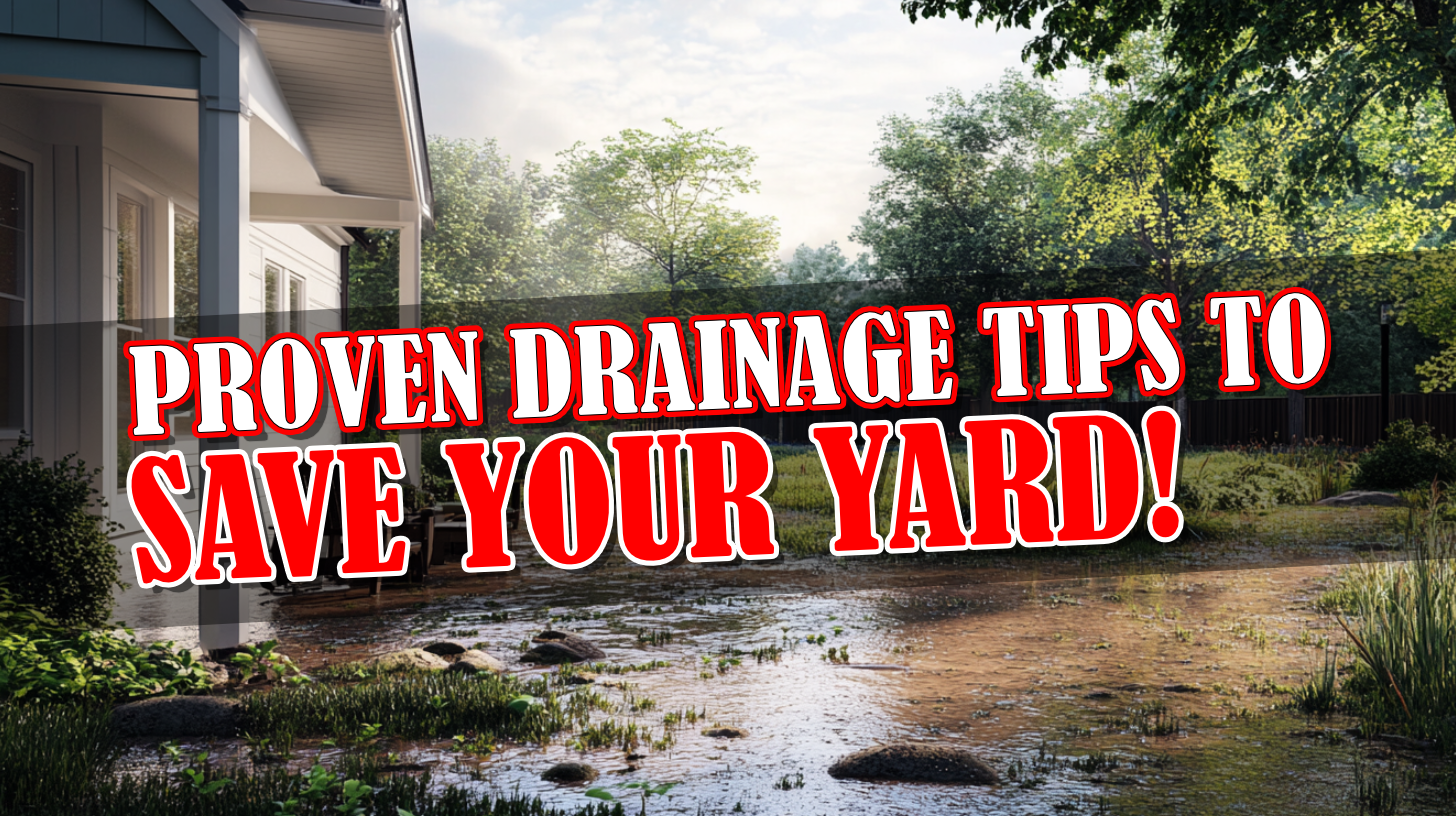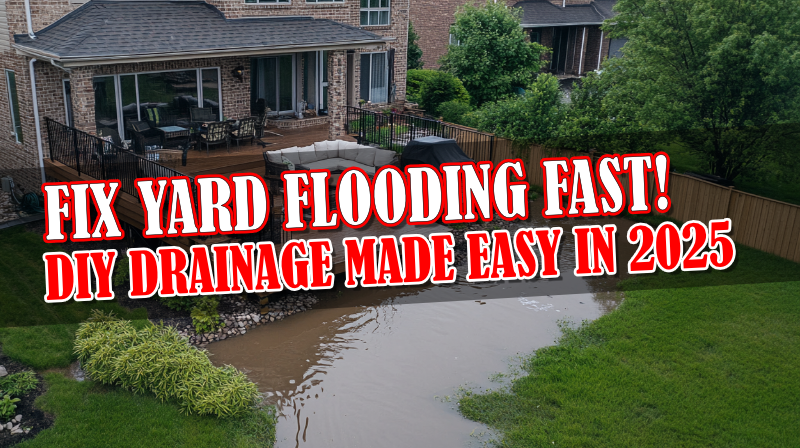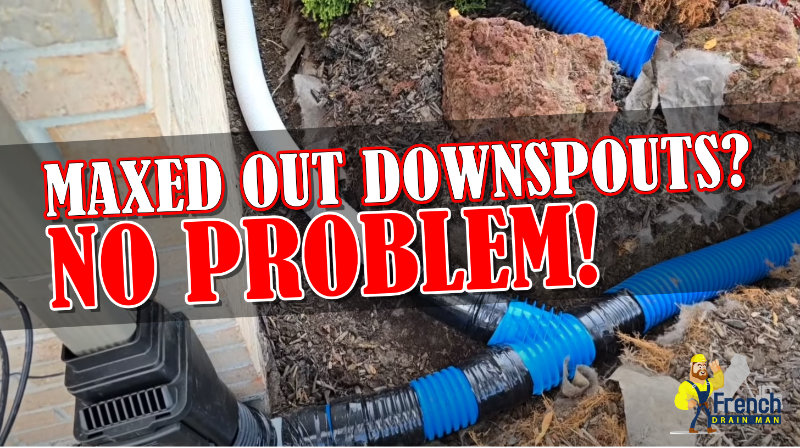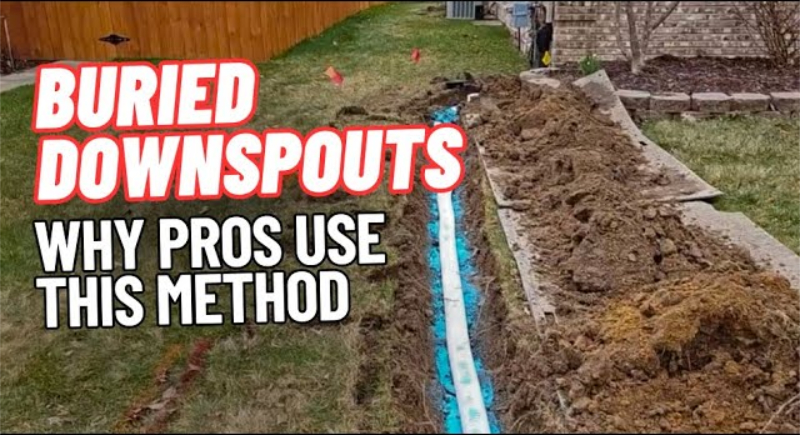I just want to clear a few things up. I’ve been going out on appointments. One out of three appointments has a failed French drain system. I’ve been out on two appointments recently where the systems were less than a year old. They weren’t French drains. Contractors are telling homeowners they are going to install a French drain, but they’re not French drains.
How to Identify a French Drain Fake – 1. Inlet Basins
I bought this double inlet basin just for this video. I don’t own one because I don’t need one when I’m building a French drain. When you dig a channel out for stone for a French drain, you fill it full of stone. If you’ve got to put surface drains, if you need to buy parts like this, grates like this and bring them to the surface, you know what they tell the homeowners? “Oh, this is going to be a great place for you to clean the pipe out from,” or this is also serving as an inlet pipe.

Well, now they’re just admitting they’re not building you a French drain. An inlet pipe for air? Are you kidding me? A vent pipe? In a French drain? If the French drain takes in the water, believe me, you don’t need a vent pipe. Then instead of hauling all the dirt away and filling this trench full of stone, what do they do? They put some pea-stone down at the bottom and then they put the dirt back in. So you’re going to avoid the cost to haul out and the cost of the additional stone would take to fill this channel. Now, if they do have a perforated pipe, water will make it to that perforated pipe until it plugs. Even if they put fabric around the pipe, or buy the pipe with a drain sleeve as we call it, this will fail. What happens is, as long as there are air pockets here in the soil, the water will make it down here to this perforated pipe.
Once this becomes compacted, (which does not take long) you’re no longer going to get water to that perforated pipe. You can get the surface water from these basins they are putting in, this inline basin system. This is some sort of surface water drain assist. I’m just saying this isn’t a French drain system that they’re selling you. It does not lower the water table. It’ll catch the surface water, but it’s not going to lower the water table. So it’s going to be squishy. And people are saying, why is it so squishy back here? I paid for a French drain. Why is it so soft back here? I’m mowing the grass and the kids are playing. It’s all squishy. Well, because this is only going to catch the surface water. That’s it.
If somebody comes to your house to sell you a French drain and they bring up an inline basin (some sort of grate that comes to the surface to catch the surface water) get them off your property. Get them off your property and out of your life before they ruin the budget for a real French drain. When shopping for a true French drain, and you want it done right the first time, give us a call.
How to Identify a French Drain Fake – 2. Surface Drains
Whoever installed this system either didn’t know any better, or they just took advantage of the homeowner by not digging out a trench or creating a channel. What they did is they went ahead and they put these surface drains, which by the way a surface drain drains the surface water. It doesn’t lower your water table. So I have a lot of issues with surface drains. You’re not going to find them in my systems and they allow contaminants into the pipe. People always say, “Oh, you can clean the pipe out from here.” You know what? You shouldn’t have to clean the pipe out, period. If it was done right, you shouldn’t have to clean it. It should be fully contained. There shouldn’t be any surface drains in this system.
All this should be is an open French drain. The water comes off the brick paver patio into an open French drain. And then the water’s gravity-fed to the corner of the lot where everything is draining. And then this patio would have been fine.
So you can see this is dirt. You see this little bit of pea-stone? You want the pipe at the bottom of the trench and you want the pipe really deep. Now the frost has heaved the surface drains and also has surfaced the pipe. This is an example of what not to do. If somebody suggests a surface drain, then they’re not building you a French drain because a French drain wouldn’t need a surface drain, or they’re building a really poor French drain with little stone and very little dirt haul out, probably using a trencher.
How to Identify a French Drain Fake – 3. The System Only Takes in the Surface Water
Here’s a completed French drain with the last piece of side yet to be put in. You can see how the channel, full of stone and pipe, is fully contained by filter fabric. This is to prevent any contamination from ever getting into the French drain system and it will never need any maintenance. It does not need surface drains. A true French drain does not need a surface inlet drains.
I had a call and it brought me out here. Somebody said the French drain system that was just installed last year is not working. Well, the complaint is the ground is extremely saturated. See these inlets, they installed a pipe, put a little bit of stone on it, put the dirt back in, and then they put a bunch of inlets in. So the standing water was gone, but they’re not going to lower the saturation. So there are inlets through the whole system. The system runs around the whole yard. They paid a lot of money for this.
It’s unfortunate when people put their trust in a contractor, and this is the kind of work that they provide. You cannot lower the saturation rate and your subsoil by putting in a system that just takes in the surface water. For a true French drain, a real French drain, installed the right way, call the French Drain Man at:248-505-3065.
A yard drain is a system with inlet basins, but it doesn’t have any stone around it. A French drain that has stone around it, you don’t want to put catch basins in that because you’re going to end up with bark, mulch, lawn clippings, dirt, everything you can imagine is going to be flowing down into your yard drain or French drain system.
So again, basins on a solid pipe, not perforated, is a yard drain. And in extreme cases of large amounts of surface water, I’ll build one inside my burrito wrapped French drain. I’m just routing a yard drain in. The problem I’m seeing, contractors want to use the same pipe for a French drain and a yard drain and that just doesn’t work, not for long anyway. It’s failure. It’s a failed experiment. I can show you guys countless numbers of jobs, every third job we’re ripping out pipe.
So the point I want to drive home here is, listen, do the burrito wrap to prevent any debris from getting into your French drain. Put your pipe right at the bottom of the trench layer, right flat on the fabric. So that way you don’t have clay coming up and plugging the pipe, and if it’s all the way at the very bottom of the pipe, in a French drain full of stone, that way you can run every little bit of water out of that system. Now, the trees and the shrubs, they cannot sniff out that water and you will not end up with a failed French drain.
How to Identify a French Drain Fake – 4. Your Drain Requires a Maintenance Schedule
Now, I know these contractors hate when I’m ratting them out, because what happens? They build these drains and then they sign you to a maintenance schedule. Well, you’re going to want us to come here and blow this debris out. We’re going to jet it. And then because they leave three inches of stone, or if they use the peanut pipe, they got that little bit of aggregate under the peanut pipe and the water can’t get out of the French drain system. There’s always water at the bottom of their systems. And that’s why they have problems where you see them pulling out roots. You see them doing these maintenance videos and they pump up their chest and they think they’re doing something so great. And these are the same guys that will actually show you a kitchen garbage can, a Rubbermaid or a storage bin, a tote, that they’re using for a sump pump basin! I don’t even know where they, where they get the courage to do that.








